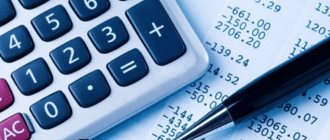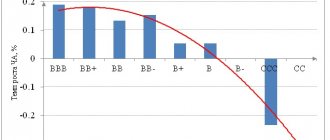Income tax (lines 2410–2400)
Lines 2410–2400 of the Report reflect income tax calculations for the reporting period.
On line 2410 “Current income tax”, indicate (in parentheses) the difference between the total turnover in the debit and credit of account 68 subaccount “Calculations for current income tax” in correspondence with the accounts:
- 09 “Deferred tax assets”;
- 77 “Deferred tax liabilities”;
- 99 subaccount “Conditional income tax expense (income)”;
- 99 subaccount “Permanent tax liabilities (assets)”.
On line 2421 “Fixed tax liabilities (assets)”, reflect the difference between the total turnover in the debit and credit of account 99 subaccount “Fixed tax liabilities (assets)” in correspondence with account 68 subaccount “Calculations for current income tax”.
On line 2430 “Change in deferred tax liabilities”, indicate the difference between the total turnover on the credit and debit of account 77 in correspondence with account 68 sub-account “Calculations for current income tax”. If the credit turnover is greater than the debit turnover, then the difference is deducted from profit (loss) before tax. If the loan turnover is less than the debit turnover, then the difference is added to profit (loss) before tax.
On line 2450 “Change in deferred tax assets”, reflect the difference between the total turnover on the debit and credit of account 09 in correspondence with account 68 subaccount “Calculations for current income tax”. If the debit turnover is greater than the credit turnover, then the difference is added to profit (loss) before tax. If debit turnover is less than credit turnover, the difference is deducted from profit (loss) before tax.
An example of how to reflect in the Financial Results Statement the permanent difference that arose during the formation of the initial cost of a fixed asset in accounting and tax accounting. The organization applies PBU 18/02
LLC "Proizvodstvennaya" applies a general taxation system.
In October 2015, the organization acquired a fixed asset and put it into operation. The amounts of the initial cost of a fixed asset, formed in accounting and tax accounting, differ. According to the accounting policy of the organization, the methods for calculating depreciation on fixed assets in accounting and tax accounting are the same.
The amount of depreciation accrued for this fixed asset for the period November–December was:
- in accounting – 57,091 rubles;
- in tax accounting – 11,157 rubles.
The amounts of depreciation in accounting and tax accounting differ due to the different procedure for forming the initial cost. Therefore, as depreciation is calculated, a permanent difference arises in accounting. Each month, this difference results in an ongoing tax liability. The accountant reflected its occurrence with the following posting:
Debit 99 “Fixed tax liabilities (assets)” Credit 68 subaccount “Calculations for income tax” - 9187 rubles. ((RUB 57,091 – RUB 11,157) × 20%) – reflects the permanent tax liability from the difference between the depreciation amounts accrued in accounting and tax accounting.
At the end of the year, “Master” did not experience any temporary differences.
At the end of the year, profit before tax was:
- according to accounting data - 11,241 rubles;
- according to tax accounting data - 57,175 rubles.
The accountant reflected the amount of the contingent income tax expense by posting:
Debit 99 subaccount “Conditional income tax expense” Credit 68 subaccount “Calculations for income tax” - 2248 rubles. (RUB 11,241 × 20%) – the amount of conditional income tax expense for the year has been accrued.
The amount of income tax according to tax accounting data (reflected on line 180 of sheet 02 of the income tax return) amounted to 11,435 rubles. (RUB 57,175 × 20%).
Information on permanent tax liabilities and contingent income tax expense for 2015 is given in the table (RUB).
| Indicator name | Debit | Credit | Difference between revolutions |
| Turnovers on account 99 subaccount “Fixed tax liabilities (assets)” in correspondence with account 68 subaccount “Calculations for income tax” | 9187 | – | 9187 |
| Turnovers on account 99 subaccount “Conditional income tax expense (income)” in correspondence with account 68 subaccount “Calculations for income tax” | 2248 | – | 2248 |
The amount of income tax reflected in accounting at the end of the reporting period for income tax must match the amount in the tax return. Therefore, the accountant checked whether the reporting period (2015) was closed correctly. To do this, he compared the total (since the beginning of the year) turnover in account 68 subaccount “Calculations for income tax” in correspondence with the accounts:
- 99 “Profits and losses” subaccount “Conditional income tax expense (income)”;
- 99 “Profits and losses” subaccount “Fixed tax liabilities (assets)”.
If the difference between the debit and credit turnovers on these accounts coincides with the amount reflected on line 180 of sheet 02 of the income tax return, then the income tax calculations are reflected correctly in the accounting records. This means that the reporting period was closed correctly.
Debit turnover on account 68 subaccount “Calculations for current income tax” is equal to 0. Credit turnover is 11,435 rubles. (9187 rub. + 2248 rub.). The amount of current income tax for the year is 11,435 rubles. (0 rub. – 11,435 rub.). Thus, the difference between debit and credit turnover on account 68 (11,435 rubles) coincided with the amount of income tax reflected on line 180 of sheet 02 of the income tax return (11,435 rubles).
The report regarding the formation of calculations for income tax and net profit (loss) was compiled by the “Master” accountant as follows:
| Title of report articles | Line codes | For 2015 |
| Profit (loss) before tax | 2300 | 11 241 |
| Current income tax | 2410 | (11 435) |
| Including permanent tax liabilities (assets) | 2421 | (9187) |
| Change in deferred tax liabilities | 2430 | – |
| Change in deferred tax assets | 2450 | – |
| Other | 2460 | – |
| Net income (loss) | 2400 | (194) |
Lines 2421, 2430 and 2450 can be left blank by three categories of organizations - these are those who have the right not to apply PBU 18/02 (clause 2 of PBU 18/02). First, small businesses. Secondly, non-profit organizations. On line 2410 “Current income tax” they reflect the difference between the total turnover in the debit and credit of account 68 subaccount “Calculations for current income tax” in correspondence with account 99 subaccount “Current income tax”.
The third category includes organizations that do not pay income tax according to the law, but must keep accounting records (clause 1 of PBU 18/02). These are, for example, payers of the gambling business tax (clause 9 of article 274 of the Tax Code of the Russian Federation, article 2 of the Law of December 6, 2011 No. 402-FZ). Such organizations, when filling out lines 2421, 2430, 2450 of the Report, can put dashes (clause 11 of PBU 4/99).
The amount of tax on the gambling business, which reduces the indicator of line 2300 “Profit (loss) before tax,” is indicated in line 2460 “Other” (letters of the Ministry of Finance of Russia dated June 25, 2008 No. 07-05-09/3 and dated August 18, 2004 No. 07-05-14/215). In this case, the organization has the right to determine the details of this line independently. The same rules should be followed by organizations that combine the general taxation system with the payment of tax on the gambling business (clause 9 of Article 274 of the Tax Code of the Russian Federation).
Situation: on which line of the Income Statement should the simplified single tax or UTII be reflected?
Reflect the tax:
- on line 2410 “Current income tax” of the Income Statement, if the organization uses the generally established form;
- on the line “Taxes on profit (income)”, if the organization is a small enterprise and uses a special simplified form.
The organization draws up a report on financial results in a generally established form . In this case, indicate the amount of single tax on line 2410 “Current income tax.” The fact is that the Statement of Financial Results, instead of information on income tax, reflects the corresponding indicators related to the payment of taxes under special tax regimes. This is stated in the Recommendations for the audit of annual accounting records for 2014 from the appendix to the letter of the Ministry of Finance of Russia dated February 6, 2015 No. 07-04-06/5027.
The organization draws up a financial performance report in a special (simplified) form . In this case, indicate the amount of the single tax in the line “Taxes on profit (income)”. This line reflects not only income tax, but also taxes on income. And the simplified single tax (UTII) is just that.
Regardless of the application of PBU 18/02, the amount of the current income tax reflected in the Report must coincide with the amount of tax indicated on line 180 of sheet 02 of the income tax return, approved by order of the Federal Tax Service of Russia dated November 26, 2014 No. MMV-7 -3/600. If they do not match, then the Report has been compiled incorrectly.
If during the reporting period the organization had other turnover in account 99 “Profits and Losses”, then in the Report reflect them on line 2460 “Other”. For example, here you need to reflect the accrued amounts of fines for taxes and fees (clause 23 of PBU 4/99), deferred tax assets written off in connection with the disposal of assets for which they were accrued (paragraph 4 of clause 17 of PBU 18/02) .
The tax office may request clarification as to why there are discrepancies between tax and accounting records. Compose them in any form.
What wiring is used?
Posting - the method of reflecting the profit received can be varied. There are two main options in modern economics. Firstly, the reflection of income at the time of shipment to the counterparty, and secondly, at the time of receipt of payment for the product/service from the counterparty.
Obviously, each posting has its own characteristics and they relate not only to the choice of account to be reflected. From an economic point of view, posting at the time of transfer of goods to the counterparty is considered more risky. If after this no settlement occurs, then the profit goes into debit debt - a debt that must be paid by the counterparty to the supplier.
As with any debts, one unpleasant thing can happen to accounts receivable - delays. Therefore, it is possible that the profit already reflected in the balance sheet will not be received in a timely manner. Another thing is the reflection of the funds actually received, everything is simpler here, because the accountant takes into account the money already received into the company’s account, the risks are minimal. Now let's talk about posting accounts:
| Operation | Debit. check | Credit. check |
| Received money for goods | 51 | 62.02 |
| Revenue from product sales is taken into account | 76 | 68 |
| Advance payment credited | 62.02 | 62.01 |
| Write-off of goods sold at sales price | 90.02.2 | 41.11 |
| Markup on goods sold | 90.02.2 | 42.01 |
Net profit (line 2400)
On line 2400 “Net profit (loss)”, indicate the result calculated using the formula:
| Net profit (loss) (line 2400) | = | Profit (loss) before tax (line 2300) | + (–) | Change in deferred tax liabilities (line 2430) | + (–) | Change in deferred tax assets (line 2450) | + (–) | Other (line 2460) | – | Current income tax (line 2410) |
Check that the net profit (loss) reflected in the Report at the end of the year coincides with the closing balance in account 99 “Profits and losses” (including rounding). It must be written off to account 84 “Retained earnings (uncovered loss)” when reforming the balance sheet.
An example of how to reflect income tax calculations in the Financial Results Report. The organization applies PBU 18/02
Alpha LLC applies a general taxation system. For 2015, the organization received a balance sheet profit in the amount of RUB 2,559,000. This indicator is reflected in line 2300 of the Income Statement.
The organization applies PBU 18/02. Information on deferred tax liabilities (assets), permanent tax liabilities (assets) and conditional income tax expense (income) for 2015 is given in the table (RUB).
| Indicator name | Debit | Credit | Difference between revolutions |
| Turnover on account 09 “Deferred tax assets” in correspondence with account 68 sub-account “Calculations for current income tax” | 55 000 | 45 000 | 10 000 |
| Turnover on account 77 “Deferred tax liabilities” in correspondence with account 68 sub-account “Calculations for current income tax” | 19 000 | 115 000 | -96 000 |
| Turnover on account 99 “Profits and losses” sub-account “Fixed tax liabilities (assets)” in correspondence with account 68 sub-account “Calculations for current income tax” | 20 000 | – | 20 000 |
| Turnovers on account 99 “Profits and losses” subaccount “Conditional income tax expense (income)” in correspondence with account 68 subaccount “Calculations for current income tax” | 511 800 | – |
The debit turnover on account 68 subaccount “Calculations for current income tax” is equal to 160,000 rubles. (45,000 rub. + 115,000 rub.). Credit turnover – RUB 605,800. (RUB 55,000 + RUB 19,000 + RUB 20,000 + RUB 511,800). The amount of current income tax for 2015 is RUB 445,800. (RUB 160,000 – RUB 605,800).
The Alpha accountant compiled the report regarding the preparation of calculations for income tax and net profit (loss) as follows (thousand rubles).
| Title of report articles | Line codes | For 2015 |
| Profit (loss) before tax | 2300 | 2559 |
| Current income tax | 2410 | (446) |
| Including permanent tax liabilities (assets) | 2421 | 20 |
| Change in deferred tax liabilities | 2430 | (96) |
| Change in deferred tax assets | 2450 | 10 |
| Other | 2460 | – |
| Net income (loss) | 2400 | 2027 |
An example of how to reflect the net profit (loss) of the reporting period in the Financial Results Report. The organization pays UTII
LLC "Torgovaya" is engaged in retail trade. Retail trade has been transferred to UTII. For 2015, the organization received a balance sheet profit in the amount of RUB 859,000. This indicator is reflected in line 2300 “Profit (loss) before tax” of the Report. The organization does not apply PBU 18/02. Therefore, when filling out lines 2421–2460 of the Report, the Hermes accountant added dashes. The credit turnover on account 68 sub-account “Settlements on UTII” of the organization for the reporting period is 64,160 rubles. The accountant showed this amount in line 2410 “Current income tax.”
The Hermes accountant compiled the report regarding the formation of net profit (loss) as follows (thousand rubles).
| Title of report articles | Line codes | For 2015 |
| Profit (loss) before tax | 2300 | 859 |
| Current income tax | 2410 | (64) |
| Including permanent tax liabilities (assets) | 2421 | – |
| Change in deferred tax liabilities | 2430 | – |
| Change in deferred tax assets | 2450 | – |
| Other | 2460 | – |
| Net income (loss) | 2400 | 795 |
Step-by-step instructions on how sales income is reflected in accounting in 1C
Finished products
- Creating a document First of all, the accountant must create a document. To do this, we go to the “Sales” subsection of the corresponding menu item. Next, find the item “Sales (acts, invoices)”, go to “Goods, services and commission”.
- Fill out the document. Enter the seller, buyer, warehouse and prices into the required lines.
- Selecting products and adding them to the table By clicking the “Add” button, you can start selecting and adding products to the table line by line. But there is a more convenient option - using the “Selection” option. With its help, you will be able to select goods from those remaining in the warehouse, immediately select quantity and price (if a certain type of price has not been previously specified).
- Posting the document If everything you need is included in the report, find and click the “credit/debit” button located at the top of the document.
Works
- Create a document Find the “Sales” menu, in it click on “Sales”, then on “Goods, services and commission”.
- We fill out the document. The program will highlight the required fields with a red dotted line. Here you need to indicate the organization of the seller, the counterparty and the cost of the work.
- We enter the completed work into the table. Add them manually or use the “selection” option.
- Posting a document The program will automatically create a posting; for this, the user needs to make just one click - on the “debit/credit” button. It is located at the top of the page, above the generated report.
Read more about what the formula for calculating sales revenue looks like and what the general algorithm for determining this indicator is here.
Services
- Create a document In the 1C program, select the “Sales” menu, go to the “Sales” subsection, here we create a document using the “Goods, services and commission” option.
- We fill out the document In the header of our report we add basic information: who provided the service to whom and at what price. Please note that when maintaining records only within one organization, the supplier field will be inactive and will not need to be filled out.
- Selecting services for the report There are two options - through the “add” button and through the “selection” button. We recommend using the second option, then you will have the opportunity to “pull” services from the list reflected earlier in the program.
- Post the document Click on the “debit/credit” button and receive ready-made transactions. If something suddenly goes wrong, you can edit the document manually (the “Manual correction” checkbox).
The need to calculate the indicator
Most businessmen start their companies out of a desire to make a profit. There are several metrics that business owners can use to determine the performance of their business. One such indicator is profit before tax.
The purpose of calculating this indicator is to determine the total amount of profit of the company, on the basis of which the amount of tax payments can be finally determined.
The profitability of a company can be calculated using the profit before tax indicator. The significance of this indicator in efficiency calculations is very high.
Book of accounting of income from sales of goods, works, services
For individual entrepreneurs
The document includes only three columns:
- in the first, the individual entrepreneur enters the date of the operation;
- in the second, he enters the proceeds from the sale of goods or services;
- in the third, indicates the document on the basis of which the volume of goods was reduced/their value was changed/returned – if any.
The data is entered every month , and the results are summarized below in the “Total” line.
For LLC
- No.;
- date and number of the primary document;
- Contents of operation;
- income taken into account when calculating the single tax;
- expenses that are also taken into account when calculating the tax.
Now you know how to correctly reflect revenue from the sale of goods or the sale of services in an accounting report. All features of financial statements are reflected in Russian legislation. Once again, we note that the main thing is the correct wiring setup. If the document does not turn out as expected, simply double-check all the accounts in the 1C program.
Calculation example
For an example of calculation, let's take a conditional company with the following initial data presented in the table below.
| Index | 2017, t.r. | 2018, t.r. |
| Revenue | 547800 | 654700 |
| Expenses | 321470 | 455900 |
| Business expenses | 12455 | 17855 |
| Administrative expenses | 9875 | 9777 |
| Income from participation | 5446 | 6511 |
| Interest receivable | 7885 | 8444 |
| Interest payable | 15477 | 19745 |
| Other income | 5423 | 2144 |
| other expenses | 7895 | 6744 |
To calculate the profit from sales, we use the table below.
| Index | 2017, t.r. | 2018, t.r. | Absolute deviation, t.r. | Rate of change, % |
| Revenue | 547800 | 654700 | 106900 | 119,5 |
| Expenses | 321470 | 455900 | 134430 | 141,8 |
| Gross profit | 226330 | 198800 | -27530 | 87,8 |
| Business expenses | 12455 | 17855 | 5400 | 143,4 |
| Administrative expenses | 9875 | 9777 | -98 | 99,0 |
| Profit from sales | 204000 | 171168 | -32832 | 83,9 |
| Income from participation | 5446 | 6511 | 1065 | 119,6 |
| Interest receivable | 7885 | 8444 | 559 | 107,1 |
| Interest payable | 15477 | 19745 | 4268 | 127,6 |
| Other income | 5423 | 2144 | -3279 | 39,5 |
| other expenses | 7895 | 6744 | -1151 | 85,4 |
| Profit before tax | 199382 | 161778 | -37604 | 81,1 |
As can be seen from the table, by 2021 there is a decrease in profit before tax by 37,604 tr. or by 18.9%. This decrease is due to the fact that the growth rate of revenue (19.5%) was lower than the growth rate of expenses (41.8%). Along with the decrease in profit before tax, one can also see a decrease in gross profit by 27,530 tr., profit from sales by 32,832 tr.
Balance sheet profit analysis
First of all, when analyzing balance sheet profit, an assessment is made of the implementation of the actual plan, which is compared with the previous reporting period.
The balance sheet profit formula is designed to solve the following problems:
- Identify the reasons and factors for non-fulfillment of the planned profit;
- Identify the weaknesses of economic activity, the unprofitable part of the enterprise;
- Find sources of loss;
- Create reserve lists for subsequent profit growth or minimization of losses.
When analyzing balance sheet profit, its structure is examined, including its composition and dynamics of the plan implemented for a certain reporting period. If indicators are studied in dynamics, then it is necessary to take into account inflation factors, while adjusting revenue by the index of the weighted average growth in the cost of goods in the industry. In this case, the cost of products sold (services, works) must be reduced by the difference in prices of resources that were used in the period under review.
Indicator analytics
Since the indicator measures the amount of profit before tax payments are calculated, then:
- an increase in value indicates the efficiency of the company;
- a decrease indicates management inefficiency and a crisis in the company.
When analyzing profit before tax, we study:
- dynamic trends of the indicator for 2-3 reporting periods in absolute terms, that is, in monetary terms;
- trends in the indicator for 2-3 reporting periods in relative terms, that is, as a percentage;
- Weaknesses are identified through the use of vertical analysis techniques for individual expense categories.








